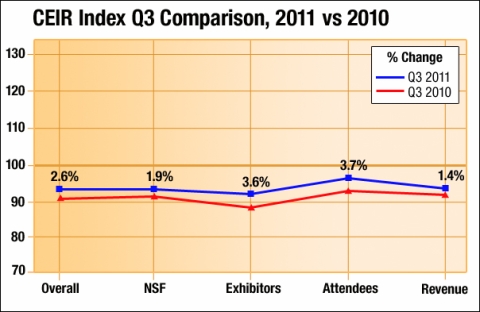CEIR Data Shows Increase in Exhibition Industry for Fifth Consecutive Quarter

The Center for Exhibition Industry’s CEIR Index showed that trade shows continued to buck overall negative economic trends in the third quarter, with 2.6-percent growth in all four key metrics tracked in the report, compared with the same quarter in 2010.
Trade show growth in the third quarter of this year also beat out the GDP during the same period, which only grew 1.5 percent.
In addition, all four key metrics tracked by the CEIR Index – attendance, number of exhibitors, revenues and net square footage - showed positive results on a year-on-year basis and the growth of all key metrics except one, net square footage, accelerated.
"The results show that the exhibition industry is healthy, vibrant and growing despite a relatively sluggish economy," said CEIR President and CEO Doug Ducate.
He added, "With five consecutive quarters of growth, we are hopeful that the growth trend continues through 2011 and well into next year."
Third-quarter trade show growth followed the positive numbers from the first half of 2011, which saw the exhibition industry gaining 2.4, outperforming the U.S. economy, which only gained 1.9 percent during the same time period.
Attendance in the third quarter, which is a healthy indication of recovery in the industry, jumped an impressive 3.7 percent, compared with 1 percent during the same period last year.
Growth in the number of exhibitors was slightly lower, 3.6 percent, compared to 0.5 percent-growth during the same period last year.
The growth of Inflation adjusted revenues also accelerated to 1.4 percent for a total $2.56 billion, compared with a year-on-year decline of 0.1 percent.
Net square footage, however, didn’t experience the same level of growth as the other three metrics, expanding just 1.9 percent, compared with the 2.8 percent-growth it had experienced during the first half of 2011.
“The Total Index results were stronger than anticipated and are also stronger than the year-on-year real GDP growth,” said CEIR Economist Allen Shaw, Ph.D., chief economist for Global Economic Consulting Associates.
He added, “With the fifth consecutive quarter of growth, we believe the exhibition industry has successfully emerged from the Great Recession and is reporting consistent, positive gains."
The CEIR Index provides exhibition industry performance across 14 key industry sectors: business services; consumer goods; discretionary consumer services; education; food; financial, legal and real estate; government; building, construction, home and repair; industrial/heavy machinery and finished business inputs; communications and information technology; medical and health care; raw materials and science; sporting goods, travel and entertainment; and transportation.


Add new comment